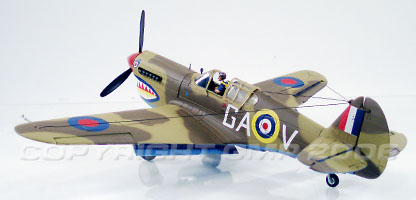No. 112 Squadron was formed on 30 July 1917 as a home defence unit at Throwley for the defence of the London area. Day and night interceptions were flown against enemy bombers until the end of WWI. The Squadron disbanded on 13 June 1919. On 16 May 1939, No. 112 reformed aboard the aircraft carrier 'Argus' at Southampton for transportation to the Middle east, arriving in Egypt ten days later. Gladiators were recieved in June and when Italy joined in the second world war the Squadron flew fighter patrols over the Western Desert. In January 1941 No. 112 moved to Greece to provide air defence and fly offensive patrols over Albania. When the Germans invaded Greece the Squadron provided fighter cover for the Athens area until evacuated first to Crete and then back to Egypt. In July 1941 No. 112 was re-equipped with Tomahawks for fighter sweeps over the desert and then the Squadron received Kittyhawks in December 1941 beginning fighter-bomber missions in May 1942. The Squadron provided support for the 8th Army during their campaign in the Western Desert and after the Allied victory at El Alamein No. 112 was moved to Tunisia. In July 1943 the Squadron was moved to Sicily and on to Italy in September receiving Mustangs in June 1944. No. 112 provided air support for the Allied armies in Italy for the rest of the war and after a period of occupation duties in northern Italy, the Squadron disbanded on 30 December 1946. This particular Kittyhawk was flown by Flight Officer Neville Duke. Neville Duke started World War II as a fighter pilot with 92 Squadron at RAF Biggin Hill. Awarded the DSO, he became an RAF test pilot towards the end of the war and continued as a peacetime test pilot with the Hawker Aviation Company. This plane features, sliding canopy with accurately detailed interior, removable top ammo doors with accurate drop in ammo box detail, opening access hatch, completely detailed engine with removeable side cowlings, functional rudder, wing flaps, opening underside gun doors with gun detail, antenna wires, all the external markings and body lines are there. But heres the part that makes us the leader in diecast replicas... the landing gear is automatic!! Yes that's right it features a small button on the underside of the plane that when pressed, acuates the landing gear to come down automatically and while coming down it rotates just like the real plane. It will blow you away the first time you see it, and all the times you will show your friends.
- ModelYear - 0
- Availability - Out of Stock


